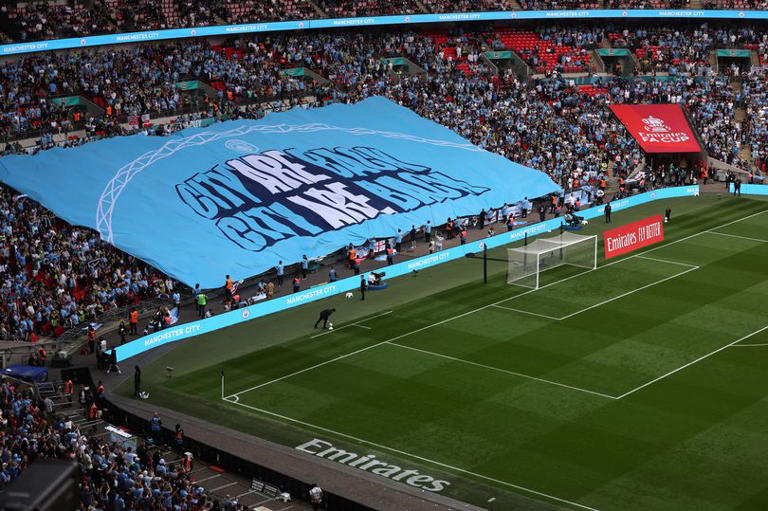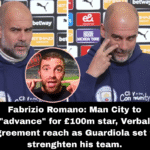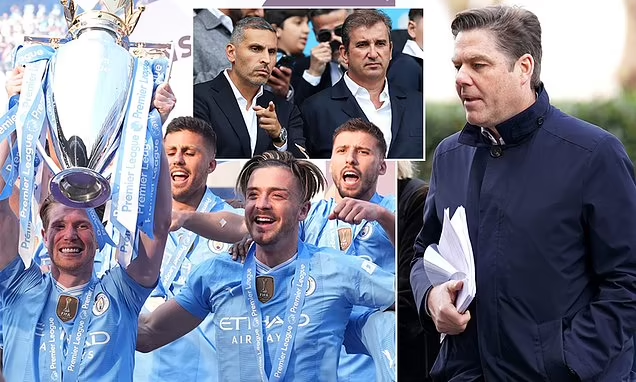Man City fans at Wembley dished out another lesson – it should be obvious by now

Manchester City fans at Wembley dished out another lesson that should be obvious by now to any keen observer of football culture in England. The narrative surrounding City supporters and their supposed indifference to major cup competitions has become something of a tired cliché in English football circles, yet it persists despite evidence to the contrary. The phenomenon was once again apparent during the recent FA Cup semi-final against Nottingham Forest, where premature judgments about attendance and enthusiasm proved to be misguided when viewed in proper context.
If you’ll permit a personal anecdote that serves as an apt metaphor for what routinely happens at these important fixtures, it reminds me of something that occurred some years ago. My parents were holidaying in Nice with friends when they discovered that the Tour de France would be passing through the picturesque coastal city. Though not particularly avid cycling enthusiasts, they were drawn to the spectacle and historical significance of the event. They positioned themselves early along the route, genuinely puzzled as to why local residents seemed more interested in the beach they could visit any day rather than witnessing this momentous sporting occasion.
Their confusion persisted until moments before the cyclists approached, at which point all the local spectators efficiently moved to the front of the sidewalk, observed the athletes in their full glory as they whizzed past, and then calmly returned to their beach activities. My parents were left with photographs primarily featuring the backs of French heads rather than the famous race they had waited hours to witness. The locals, with their intuitive understanding of the event’s timing and progression, maximized their experience with minimal waiting, while the tourists, lacking this cultural knowledge, spent hours for a fleeting glimpse.
This same dynamic was evident at Wembley Stadium during the FA Cup semi-final. Before kickoff, conversation swirled about how Nottingham Forest supporters seemed to dominate the landscape around Wembley, their distinctive red shirts visible throughout the stadium approaches. Their designated end appeared practically full well before the match began – a stark contrast to the apparently sparsely populated Manchester City section, which filled more gradually and with less visible fanfare.
This visual disparity fueled the persistent narrative about City fans’ supposed lack of passion or commitment compared to supporters of clubs with more traditional working-class roots. It’s a convenient storyline that fits neatly into football’s established mythology: the nouveau riche club with fair-weather fans versus the authentic supporters of a historic, if recently less successful, institution. The pre-match optics certainly suggested this conclusion to casual observers.
However, context matters tremendously in understanding fan behavior. Manchester City supporters have, over the past decade, become accustomed to reaching the final stages of multiple competitions each season. For many, the FA Cup semi-final represents not an exceedingly rare occasion but rather another stepping stone in what has become a routinely successful campaign. This is not to suggest arrogance or entitlement, but rather a different relationship with these milestone matches than exists for clubs whose appearances at Wembley are more infrequent.
The geography plays a significant role as well. Manchester lies approximately 200 miles from London, making match day a considerable journey for City supporters. Many arrive closer to kickoff after navigating the motorways or railway system from the Northwest. Nottingham Forest fans, while also traveling a substantial distance, represent a fanbase for whom this particular fixture carried enormous significance – their first FA Cup semi-final appearance in decades. The disparity in visible excitement before kickoff reflects these contextual differences rather than any fundamental distinction in loyalty or passion.
What often goes unremarked upon is how quickly and efficiently the City end filled as kickoff approached. Like the French locals at the Tour de France, City supporters have developed an intuitive understanding of timing that maximizes experience while minimizing unnecessary waiting. They have become pragmatic through experience, arriving with sufficient time but little excess, having learned through repetition precisely how to manage these occasions.
This pragmatism extends to their in-stadium behavior as well. The City faithful demonstrate their support in ways that might appear subdued to outsiders but reflect a mature relationship with success. There’s less of the nervous energy that characterizes supporters unaccustomed to such occasions and more of the measured confidence of those who have been here before. They save their most vocal support for the moments when the team truly needs it rather than maintaining a constant fever pitch that can’t be sustained throughout ninety minutes.
The aftermath of goals and the final whistle reveals the true depth of passion. When City scored against Forest, the explosion of joy was unrestrained and authentic. The celebrations at the conclusion of the match demonstrated genuine appreciation for what the team had accomplished. These moments of intensity, rather than constant performative displays of support, reflect a sophisticated fan culture that has evolved alongside the team’s rise to prominence.
Critics often mistake this evolution for apathy, but it represents something quite different: a maturation of the relationship between supporters and club. City fans have developed a sustainable approach to supporting a team that routinely competes in the latter stages of multiple competitions each season. This sustainability doesn’t diminish their passion; it simply distributes it differently across the football calendar than might be the case for supporters who experience such occasions more rarely.
The economics of modern football also plays a significant role in this dynamic. Consistently following Manchester City through domestic and European campaigns represents a substantial financial commitment. Many supporters must make calculated decisions about which matches to attend in person, particularly when consecutive weekends might feature crucial fixtures in different competitions. What appears as inconsistent support might actually reflect the practical realities of following an exceptionally successful team through a congested calendar.
The media narrative surrounding City’s support rarely accounts for these nuances. There’s a persistent desire to frame the club’s recent success as somehow artificial or unearned, and portraying the fanbase as less passionate or authentic than their counterparts serves this narrative. But this framing ignores the club’s rich history and decades-long support through periods of significant struggle. City’s fanbase remained remarkably loyal during years in lower divisions, a fact conveniently overlooked in contemporary discussion.
Many of today’s regular attendees at the Etihad Stadium and at away fixtures like the FA Cup semi-final earned their supporter credentials during those leaner times. They followed the club when success seemed a distant dream rather than a regular expectation. The suggestion that these same supporters have somehow become indifferent to achievement because it occurs more frequently now misunderstands the psychology of fandom. The joy hasn’t diminished; it has simply been tempered by experience and context.
What we witnessed at Wembley was not a disparity in passion but a difference in expression. Forest supporters, celebrating a rare appearance at this stage of the competition, naturally demonstrated more visible excitement in the build-up. City fans, for whom such occasions have become more routine, expressed their support in ways that reflected their particular circumstances and experiences. Neither approach is more valid or authentic than the other; they simply represent different points in the continuum of football support.
The contrast becomes particularly stark when considering European fixtures. City supporters travel in significant numbers across the continent, making arduous midweek journeys to support their team. These trips require considerable commitment of time and financial resources, yet they’re often undertaken without the recognition afforded to other clubs’ traveling support. The narrative of indifference persists despite evidence of sustained commitment across multiple competitions and geographic boundaries.
Another factor often overlooked is the changing demographic of football support across all clubs. The prohibitive cost of attending elite-level matches has altered the composition of crowds throughout the Premier League. The traditional working-class base that formed the core of English football support for generations has been partially displaced by more affluent spectators. This shift affects the atmosphere and visible expressions of support at all clubs, not just Manchester City, yet City often bears a disproportionate share of criticism for these broader sociological changes.
The relationship between a club and its supporters evolves over time, influenced by success, failure, and changing circumstances. What we’re witnessing with Manchester City is this evolution happening in compressed time due to the rapid transformation of the club’s fortunes. Supporters are adapting to sustained success after decades of unpredictability, developing new traditions and patterns of support that reflect their current reality rather than football’s romantic past.
This adaptation doesn’t indicate diminished passion but rather a realignment of expectations and expressions. The intensity remains, but it manifests differently than it might for clubs experiencing success more sporadically. City supporters have developed a longer-term perspective, understanding that each individual match, while important, forms part of a broader campaign that increasingly extends across multiple competitions and many months.
The FA Cup semi-final against Nottingham Forest exemplified this dynamic perfectly. Before kickoff, the visual impression favored the narrative of Forest’s superior support, with their end filled earlier and their colors more prominently displayed around the stadium. Yet as the match progressed, the City supporters demonstrated their commitment through focused and timely vocal support. The difference wasn’t in degree of passion but in its expression and timing – much like those locals in Nice who knew precisely when to position themselves for the Tour de France.
What’s particularly interesting about this phenomenon is how it represents a microcosm of broader changes in football culture. As the sport has become more commercial and success more concentrated among a smaller group of elite clubs, traditional metrics of supporter passion have become increasingly outdated. The binary notion that “proper” fans must constantly demonstrate visible excitement regardless of context fails to account for how the experience of supporting a consistently successful team differs from supporting one for whom major occasions are rarities.
Manchester City supporters have pioneered a new model of sustainable support for a team that regularly competes at the highest level across multiple competitions. This model includes calculated decisions about attendance, strategic expressions of vocal support during matches, and a measured relationship with both success and disappointment. It represents an evolution rather than a diminishment of traditional football support.
The criticism directed at City’s fanbase often reveals more about football’s resistance to change than about any actual deficiency in passion or commitment. There’s a nostalgic attachment to particular expressions of support that were born in different circumstances – when ticket prices were lower, success was less concentrated, and the football calendar less congested. As these circumstances have changed, so too has supporter behavior, yet the expectations have remained largely static.
What happened at Wembley was predictable to anyone who regularly observes these dynamics. Forest supporters, celebrating a significant milestone in their recent history, arrived early and in visible force. City fans, for whom the occasion represented another important but not extraordinary step in their season, arrived more gradually but no less purposefully. By kickoff, both ends were filled with passionate supporters, each expressing their allegiance in ways that reflected their particular relationship with the occasion.
After the final whistle confirmed City’s progression to another final, their supporters celebrated appropriately – with joy tempered by the knowledge that this success, while significant, is just one component of a potential treble or quadruple campaign. This measured response doesn’t reflect indifference but perspective. It’s the response of a fanbase that understands where this particular achievement fits within the broader aspirations of an exceptionally ambitious season.
Perhaps what’s most remarkable about this dynamic is how consistently it repeats itself, despite equally consistent evidence that the narrative of indifferent City support is fundamentally flawed. At each major fixture, particularly at neutral venues like Wembley, the same observations are made before kickoff, and the same conclusions drawn. Yet by the time the match ends, the reality of City’s substantial and passionate support has once again been demonstrated.
The persistence of this narrative despite contradictory evidence suggests that it serves purposes beyond mere observation. It offers a convenient way to diminish City’s achievements, suggesting that the club’s success occurs in an emotional vacuum rather than being celebrated by a passionate community of supporters. It provides reassurance to supporters of traditionally successful clubs that, despite City’s recent dominance, something essential is still missing from their success.
In reality, what’s missing is not passion but history – not the club’s actual history, which is rich and substantial, but the history of sustained success at the highest level that clubs like Liverpool, Manchester United, and Arsenal have accumulated over many decades. This historical foundation creates a different relationship between club and supporters, but the difference is one of context rather than authenticity or depth.
City supporters are now writing a new chapter in their club’s history, one characterized by consistent excellence and historic achievements. Their relationship with this era naturally differs from relationships forged during periods of struggle or inconsistency. The manner in which they express their support reflects this new reality rather than any deficiency in commitment to the club.
What we witnessed at Wembley was not a lesson in disparate levels of passion but a demonstration of different expressions of it. Forest supporters, celebrating a rare semi-final appearance, displayed their enthusiasm in more immediately visible ways. City fans, accustomed to such occasions but no less invested in the outcome, expressed their support in patterns developed through repeated experience of similar fixtures.
Neither approach is more valid or authentic than the other. Both represent genuine connections between supporters and clubs, expressed in ways that reflect their particular circumstances and histories. The tendency to value one expression over another reveals more about football’s resistance to evolving supporter cultures than about the relative merits of different approaches to fandom.
As Manchester City continues its remarkable progression under Pep Guardiola’s management, its supporter culture will continue to evolve in response to sustained success. This evolution represents not a dilution but an adaptation – the development of sustainable patterns of support for a team that routinely competes at the highest level across multiple competitions. Understanding this dynamic requires moving beyond simplistic narratives about “proper” support and recognizing the complex interplay between success, expectation, and expression.
The scenes at Wembley before, during, and after the FA Cup semi-final offered another opportunity to observe this evolution in action. For those willing to look beyond preconceived notions, they provided not evidence of indifference but insight into how supporter culture adapts to changed circumstances. Like those locals in Nice who knew exactly when to position themselves for the Tour de France, City fans have developed an intuitive understanding of how to navigate their team’s remarkable journey.
What remains constant amid this evolution is the fundamental connection between supporters and club. The expressions may change, the timing may differ, but the underlying passion remains. City fans celebrate each success while maintaining perspective on where it fits within broader ambitions. This approach doesn’t diminish their joy but contextualizes it within an unprecedented era of achievement.
As the football world continues to evolve, with increasing commercialization and concentration of success, supporter cultures across all clubs will continue to adapt. What we’re witnessing with Manchester City represents not an anomaly but a preview of how sustained success shapes the relationship between clubs and supporters. Rather than measuring these changing expressions against nostalgic ideals of “proper” support, we might better understand them as rational adaptations to new realities.
The lesson dished out at Wembley was indeed obvious for those willing to see it: supporter passion manifests differently in different contexts, but its depth and authenticity cannot be judged by superficial observations or preconceived narratives. City fans, like those French locals at the Tour de France, have simply learned through experience how to maximize their engagement with recurring events. This pragmatism doesn’t diminish their passion; it simply reflects the evolution of a supporter culture in response to unprecedented success.
As Manchester City moves forward in its quest for more silverware across multiple competitions, its supporters will continue to develop patterns of engagement that reflect their particular circumstances. These patterns may not always align with traditional expectations of how football support should look, but they represent no less valid or authentic expressions of the fundamental connection between club and community. The sooner this reality is recognized, the sooner we can move beyond simplistic narratives about supporter cultures and appreciate the rich diversity of expressions that constitute modern football fandom.














